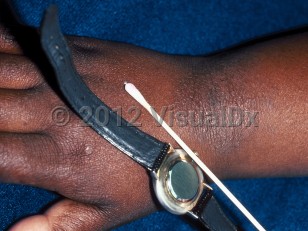Contact dermatitis can be due to either allergic or irritant causes. Irritant contact dermatitis is due to nonimmunologic local exposure of the skin to an irritating substance. Allergic contact dermatitis is a cutaneous inflammatory process (type IV cell-mediated or delayed hypersensitivity reaction) localized to areas where allergens contact the skin. Initial sensitization and development of cutaneous inflammation takes 1-4 weeks; however, repeat exposure produces reactions within 48 hours.
In children, allergic contact dermatitis is more common after the age of 5 years, but younger children can become sensitized. The incidence and prevalence of contact dermatitis has increased steadily over the decades; an estimated 4.4 million children are affected in the United States. This figure reflects those presenting for evaluation; many more affected children may remain undiagnosed.
The most common contact allergens in children are:
- Fragrance (eg, balsam of Peru [Myroxylon balsamum var pereirae]) and preservatives (eg, formaldehyde, quaternium-15, methylchloroisothiazolinone / methylisothiazolinone) – contained in cosmetic and personal care products for the child and parent, toys, glue, perfume, slime, household cleaning products, laundry detergents
- Nickel – jewelry, food, toys, clothing, snaps on clothing, electronics
- Cobalt – metal-plated products, crayons, deodorant (see also cobalt toxicity)
- Dichromate – leather products (eg, straps, shoes)
- Neomycin and bacitracin – topical antibiotics
- Oxybenzone – sunscreens
- Lanolin (Amerchol L101), propylene glycol, cocamidopropyl betaine – emollients and surfactants found in baby soap, shampoo, moisturizer, lip balm, cosmetics, packaged foods, cleaning products
American Contact Dermatitis Society Allergen of the Year:
- 2020 – Isobornyl acrylate, an acrylic monomer often used as an adhesive in medical devices. There have been multiple case reports of diabetes patients developing contact allergies to their insulin pumps. Clinician awareness is important because testing using routine panels does not identify isobornyl acrylate.
- 2021 – Acetophenone azine, thought to be formed in situ through reactions between ethyl vinyl acetate, which is present in foams used for cushioning in shin pads and footwear, and other additives. Reactions have been noted mostly in children and teens ("soccer shin" contact dermatitis).



 Patient Information for
Patient Information for 
